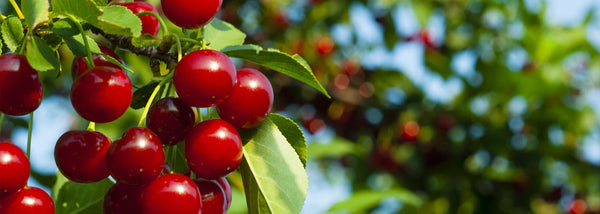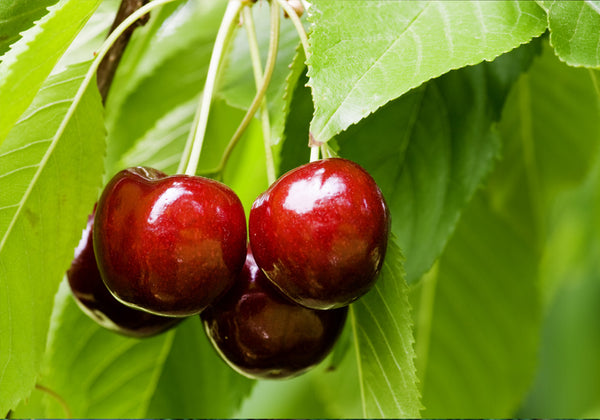Temperatures are warming up, and we’re starting to see beautiful blooming flowers. Cherry Trees have large, prized blooms, with colors that range from white as cotton to dark pink. Flowering Cherry Trees are so beautiful that people will get them just for their ornamental value! However, fruiting trees have beautiful flowers as well.
Plus, picking your own sweet cherries from your backyard to snack on can be one of nature’s most rewarding experiences. We want you to have the beautiful blooms and the fruit, so we’re going to tell you how to get the most cherries.

Planting
When choosing your Cherry Trees, make sure that you pick the ones that will do best in your area. Black Tartarians grow well in zones 5 to 8, while the Rainier Cherry Tree is recommended for growing zones 4 to 8. It may not sound like there’s a big difference between zones 4 and 5, but zone 4 gets about 10 degrees colder on average than zone 5, and that’s enough to affect the amount of cherries that you’ll receive.
Cherry Trees will adapt to your natural soil, even if it’s sandy or heavy in clay, as long as it’s well draining. It’s true that Cherry Trees like moist soil, but they don’t like soil that’s soggy or oversaturated. An area of your yard that collects a lot of standing water, or that’s prone to flooding, should be avoided.
Pollination
Even though some varieties like the Stella are self-fertile, sweet Cherry Trees produce much more fruit when cross-pollinated with another variety.Most Cherry Trees act as great pollinators for each other. The Bing, Black Tartarian, Rainier and Stella will all cross-pollinate with each other. The self-pollinating varieties act as the best pollinators for other Cherry Trees. It’s best to get two different varieties that flower around the same time.
We recommend getting two of your favorite types of Cherry Trees, then get a third Cherry Tree of a different variety that blooms around the same time. To get a good idea of which trees bloom and produce fruit around the same time, refer to the chart below.

Care
Once your trees are set up with the proper sunlight and a different variety to cross-pollinate, be sure to properly care for them.
Cherry Trees enjoy moist soil. They need an inch of water every two weeks while they’re young. It may be a good idea to keep up with the rainfall with weather reports, or a rain gauge to see how much rainwater your trees are getting. During times of drought, your trees may need a little extra water.
Placing a layer of mulch around the base of your tree that’s about 3 inches thick will help your soil retain moisture. The mulch will also moderate the temperature of the soil, so your tree will cool off or warm up slowly.
Fertilizing Cherry Trees
Another great thing that mulch does? Keep grass and weeds at bay. Grass and weeds can compete with your trees for nutrients! Cherry Trees need these nutrients in order to provide enough energy for growing tons of fruit.
Speaking of nutrients, Cherry Trees do benefit from a little fertilizer. Use a fertilizer that’s low in nitrogen late in the winter, or in the early spring. About a month before your trees flower is the best time to fertilize. Fertilizers have charts on the package that recommend how much you should use based off the size of your tree – we suggest using half of that amount for Cherry Trees.
When looking at fertilizer ratios like 5-10-10, or 15-10-5, this is the NPK ratio. NPK stands for Nitrogen, Phosphorus, and Potassium. This means that the first number is the amount of nitrogen in the fertilizer – and for these trees, you should make sure it’s low!
Keep an eye on your tree. Look out for cracked cherries, moldy leaves, or broken branches. If you spot something that seems to be a problem, like rotting fruit or an unclean break in a branch, remove it.
Pests and Diseases
Like every tree, there is a chance for pests and diseases, even if some trees are more susceptible to problems than others. The good news is that Cherry Trees respond extremely well to organic pesticides and fungicides, so they don’t need any harmful chemicals!
Prune your Cherry Trees during late winter. Be sure to remove any crisscrossing branches, or ones that are touching. These branches can break, and unclean breaks can lead to infections. Remove any dead or damaged branches to prevent infections as well. It’s also important to thin the middle of tree in order to promote air circulation through the canopy.
Air will knock out mold and mildew, and thinning the middle will also allow more sunlight to hit more branches. Sunlight also plays a key role in knocking out molds and mildews.
If you see new growth at the bottom of your tree that looks like it may be a new, smaller tree growing, or just like a large weed, remove it. This is called a sucker, and it steals nutrients from the rest of your tree!
Birds
Birds have caught on to the fact that sweet cherries are delicious. They can eat all of your cherries before you realize that they’ve started growing. To prevent birds from feasting on your fruit, you can cover your trees with bird nets. They allow sunlight and air through to your tree but prevent birds from getting to your fruit.
If you don’t want to cover your tree, you can trick birds by placing fake snakes and owls in or around your trees. This method often scares birds away, depending on how smart and brave the birds in your area are!
Healthful and happy: Two words to describe our Cherry Trees. Check out a few of your own today!





